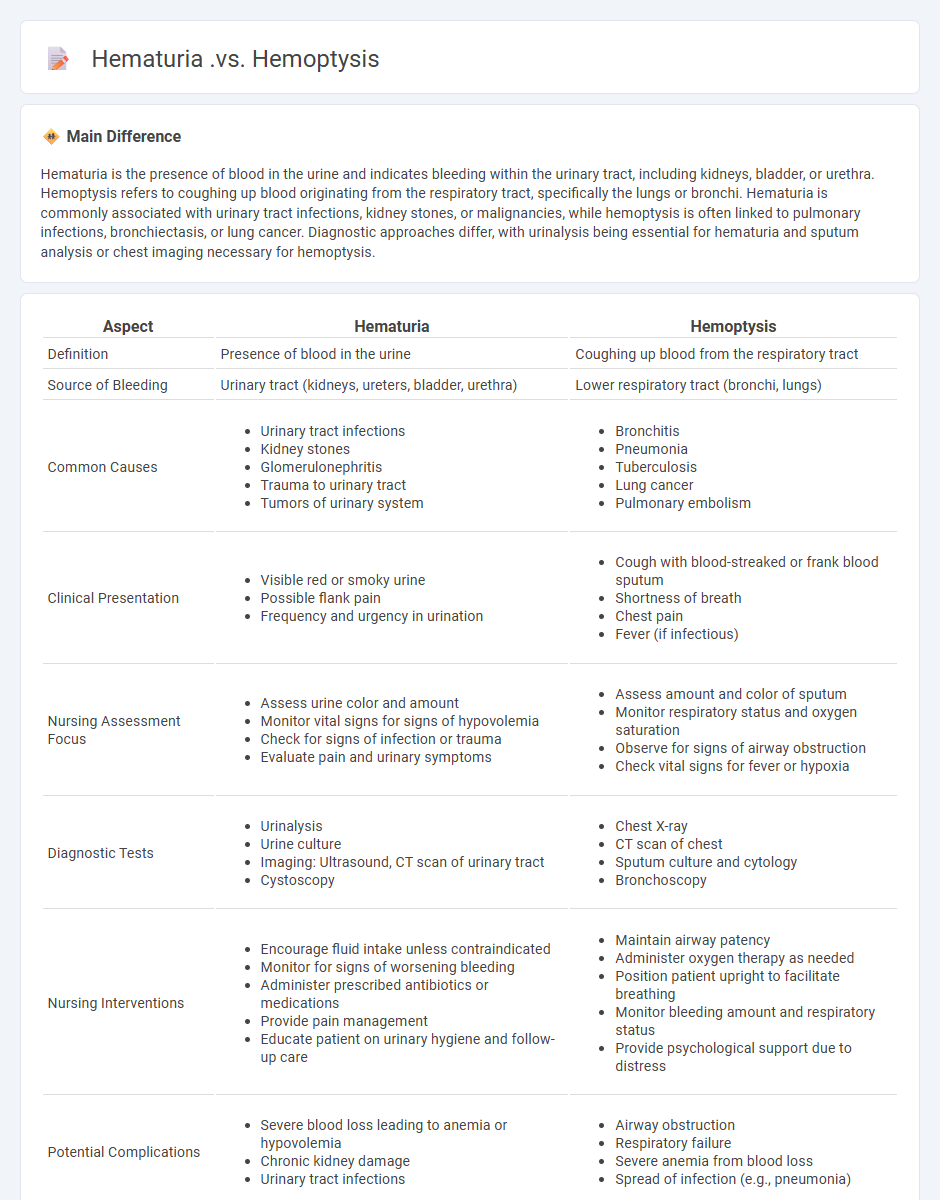
Hematuria refers to the presence of blood in the urine, often indicating issues within the urinary tract such as infections, kidney stones, or tumors. Hemoptysis involves coughing up blood from the respiratory tract, commonly caused by bronchitis, pneumonia, or lung cancer. Explore detailed differences in symptoms, causes, and diagnostic approaches to distinguish between hematuria and hemoptysis.
Main Difference
Hematuria is the presence of blood in the urine and indicates bleeding within the urinary tract, including kidneys, bladder, or urethra. Hemoptysis refers to coughing up blood originating from the respiratory tract, specifically the lungs or bronchi. Hematuria is commonly associated with urinary tract infections, kidney stones, or malignancies, while hemoptysis is often linked to pulmonary infections, bronchiectasis, or lung cancer. Diagnostic approaches differ, with urinalysis being essential for hematuria and sputum analysis or chest imaging necessary for hemoptysis.
Connection
Hematuria and hemoptysis can both be symptoms of systemic diseases such as Goodpasture syndrome, which causes autoimmune damage to the basement membranes in the lungs and kidneys. The presence of anti-glomerular basement membrane antibodies leads to simultaneous bleeding in the respiratory tract and urinary system, manifesting as hemoptysis and hematuria respectively. Recognizing this connection is crucial for timely diagnosis and treatment to prevent severe organ damage.
Comparison Table
| Aspect | Hematuria | Hemoptysis |
|---|---|---|
| Definition | Presence of blood in the urine | Coughing up blood from the respiratory tract |
| Source of Bleeding | Urinary tract (kidneys, ureters, bladder, urethra) | Lower respiratory tract (bronchi, lungs) |
| Common Causes |
|
|
| Clinical Presentation |
|
|
| Nursing Assessment Focus |
|
|
| Diagnostic Tests |
|
|
| Nursing Interventions |
|
|
| Potential Complications |
|
|
| Patient Education |
|
|
Hematuria
Hematuria refers to the presence of blood in the urine, which can indicate underlying conditions such as urinary tract infections, kidney stones, or malignancies. Nursing assessment involves evaluating the color changes in urine, patient history, and potential symptoms like pain or frequency. Diagnostic measures include urinalysis, imaging studies, and sometimes cystoscopy to determine the source of bleeding. Early recognition and accurate documentation guide appropriate interventions and referrals to prevent complications.
Hemoptysis
Hemoptysis refers to the expectoration of blood originating from the lower respiratory tract, often signaling underlying pulmonary conditions such as bronchitis, tuberculosis, or lung cancer. Accurate assessment includes quantifying the amount of blood, determining its source, and evaluating associated symptoms like cough, fever, or dyspnea. Diagnostic tools such as chest X-rays, CT scans, and bronchoscopy are essential for identifying etiology and guiding treatment. Nursing management focuses on airway protection, oxygen therapy, monitoring vital signs, and coordinating prompt medical intervention to prevent respiratory compromise.
Differential Diagnosis
Differential diagnosis in nursing involves systematically distinguishing between diseases or conditions presenting with similar clinical features to ensure accurate patient assessment and care. Nurses utilize comprehensive patient history, physical examination, and diagnostic test results to rule out alternative causes of symptoms, improving treatment precision. Mastery of differential diagnosis enhances critical thinking and clinical decision-making, contributing to safer patient outcomes and efficient healthcare delivery. Integrating evidence-based protocols and interdisciplinary collaboration supports refining differential diagnosis in nursing practice.
Assessment Techniques
Assessment techniques in nursing involve systematic methods to gather comprehensive patient data, including inspection, palpation, percussion, and auscultation. Skilled use of these techniques enables accurate identification of patients' physical conditions, contributing to effective care planning and intervention. Advanced tools such as electronic stethoscopes and portable ultrasound devices enhance precision during the assessment process. Consistent application of standardized protocols like the ABCDE approach ensures thorough evaluation of airway, breathing, circulation, disability, and exposure parameters critical in emergency and routine nursing care.
Management Strategies
Effective management strategies in nursing focus on enhancing patient care quality, optimizing resource allocation, and fostering a collaborative team environment. Implementing evidence-based practices and utilizing data-driven decision making improve clinical outcomes and operational efficiency. Leadership approaches such as transformational and servant leadership promote staff engagement and professional development in healthcare settings. Consistent evaluation and adaptation of management protocols ensure alignment with regulatory standards and evolving patient needs.
Source and External Links
Goodpasture Syndrome - Pulmonary Disorders - Hemoptysis is coughing up blood from the lungs, while hematuria is the presence of blood in the urine, often indicative of kidney or urinary tract involvement.
Hematuria (Blood in the Urine) In Adults - Hematuria refers to blood in the urine, which can arise from the kidneys, ureters, bladder, or urethra, and may or may not be visible to the naked eye.
Pulmonary hemorrhage with hematuria: do not forget IgA ... - Hemoptysis involves expectoration of blood originating from the respiratory tract, whereas hematuria stems from the genitourinary system, and simultaneous occurrence can signal serious underlying conditions like pulmonary-renal syndromes.
FAQs
What is hematuria?
Hematuria is the presence of red blood cells in the urine, indicating potential urinary tract injury, infection, or disease.
What is hemoptysis?
Hemoptysis is the medical term for coughing up blood or blood-stained mucus from the respiratory tract.
What causes hematuria?
Hematuria is caused by urinary tract infections, kidney stones, trauma, tumors, glomerulonephritis, or prostate issues.
What causes hemoptysis?
Hemoptysis is caused by lung infections, bronchiectasis, tuberculosis, lung cancer, pulmonary embolism, and trauma to the respiratory tract.
How is hematuria diagnosed?
Hematuria is diagnosed through a urine analysis (urinalysis) to detect red blood cells, followed by microscopic examination, imaging tests like ultrasound or CT scan, and sometimes cystoscopy to identify the source of bleeding.
How is hemoptysis diagnosed?
Hemoptysis is diagnosed through patient history, physical examination, chest X-ray, computed tomography (CT) scan, sputum analysis, bronchoscopy, and laboratory tests to identify the source and cause of bleeding.
Why is it important to differentiate between hematuria and hemoptysis?
Differentiating between hematuria and hemoptysis is crucial because hematuria indicates blood in the urine originating from the urinary tract, requiring evaluation for renal or urological conditions, while hemoptysis involves coughing up blood from the respiratory tract, necessitating assessment for pulmonary or bronchial diseases.
 calledges.com
calledges.com